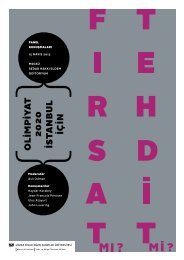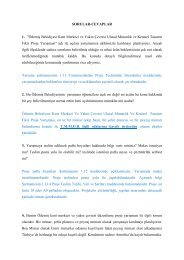VitrA ÃaÄdaÅ Mimarlık Dizisi - Arkitera
VitrA ÃaÄdaÅ Mimarlık Dizisi - Arkitera
VitrA ÃaÄdaÅ Mimarlık Dizisi - Arkitera
You also want an ePaper? Increase the reach of your titles
YUMPU automatically turns print PDFs into web optimized ePapers that Google loves.
their numbers. Accommodation facilities have been grouped as holiday camps, holiday<br />
hotels, business hotels, spa hotels, thematic hotels, boutique hotels, design hotels, art<br />
hotels, hip hotels, etc. according to the different understandings of design or the service<br />
they provide. Today hotels are aiming to become destinations themselves, with<br />
the activities they are creating, rather than merely being places to stay overnight. And<br />
already in the 20th century, as a result of their marketing techniques and purpose of<br />
creating a destination, hotels were becoming iconic images for postage stamps and<br />
postcards.<br />
It is possible to see hotels designed with modern, post-modern, eclectic, kitsch, minimalist<br />
or maximalist architectural approaches and various “themes” in today’s tourism<br />
world, which develops depending on stressing differences in an intense competition<br />
environment and aims to present what is popular in a novel way. While internationalist<br />
tendencies were once effective in hotel design, later the use of local references and<br />
search for identity came into prominence. Rather than the decisiveness of need, emphasis<br />
was placed on artificial identity. The identity got even ahead of the product, and<br />
has become a part of hotel input and marketing systems. Especially after the 1980s the<br />
basic criteria of hotel design became “creating environments for making tourists happy<br />
and meeting their expectations” and “being liked”.<br />
In hotels all around the world, entertainment events, various shows and demonstrations<br />
as well as animations have come into prominence, and by combining consumption and<br />
entertainment, consumption has been transformed into an action which gives pleasure<br />
(Yırtıcı, 2002). The tendency in the tourism sector is shifting towards presenting different<br />
images and dream worlds, with the investors trying to find the answer to “how can<br />
we make people happy and make them come here again?” (Hess, 1997 p. 77) Today’s<br />
consumers want to go far away from their daily routines and gain different experiences<br />
on holidays. This creates a tension between popular values and settled permanent<br />
values. However organized, stable and reliable their daily routine is, on holidays they want<br />
eye-catching, fashionable and tailor-made lifestyles, and to gain different experiences,<br />
be excited, take part in the lives of other people temporarily and borrow their images.<br />
There is no doubt that the temporarily lifestyle on a holiday is much more attractive<br />
and entertaining than routine, calm and permanent life. In this way, the new hotel design<br />
goes beyond accommodation, encourages nomadic life by presenting interesting<br />
designs, desired lives, different settings and stages and meets continuously changing<br />
consumers demands (Collins, 2001). New hotel guests are neither temporary nor permanent;<br />
they are sophisticated consumers who act, play, entertain, eat and sleep. They<br />
want to end their holidays with a relieved soul full of excitement and a refreshed brain<br />
The target in hotel design is providing an environment where the visitors can turn<br />
their own fantasies and dreams into projects. The hotel is transformed into a scene, a<br />
movie set where visitors can learn a lot about themselves and fulfill their dreams. The<br />
French designer Philippe Starck is one of the leading representatives of this change in<br />
the design of hotel. Since 1980s, Starck has been trying to sense the needs and desires<br />
of the premium consumers of the information age and has been doing this within a rising<br />
fashion virtuosity (Riewoldt, 2002, s. 7-11). Besides Starck, many designers like Andree<br />
Putman, Christian Liaigre, Rafael Vinoly, David Chipperfield, David Rockwell, Richard<br />
Meier, Jean Nouvel are among the pioneers of new hotel design; their designs have<br />
become prized destinations in a short time and are imitated by many others.<br />
36

















